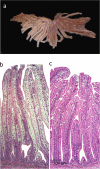Choline supplementation prevents diet induced gut mucosa lipid accumulation in post-smolt Atlantic salmon (Salmo salar L.)
- PMID: 32005242
- PMCID: PMC6995171
- DOI: 10.1186/s12917-020-2252-7
Choline supplementation prevents diet induced gut mucosa lipid accumulation in post-smolt Atlantic salmon (Salmo salar L.)
Abstract
Background: Various intestinal morphological alterations have been reported in cultured fish fed diets with high contents of plant ingredients. Since 2000, salmon farmers have reported symptoms indicating an intestinal problem, which we suggest calling lipid malabsorption syndrome (LMS), characterized by pale and foamy appearance of the enterocytes of the pyloric caeca, the result of lipid accumulation. The objective of the present study was to investigate if insufficient dietary choline may be a key component in development of the LMS.
Results: The results showed that Atlantic salmon (Salmo salar), average weight 362 g, fed a plant based diet for 79 days developed signs of LMS. In fish fed a similar diet supplemented with 0.4% choline chloride no signs of LMS were seen. The relative weight of the pyloric caeca was 40% lower, reflecting 65% less triacylglycerol content and histologically normal gut mucosa. Choline supplementation further increased specific fish growth by 18%. The concomitant alterations in intestinal gene expression related to phosphatidylcholine synthesis (chk and pcyt1a), cholesterol transport (abcg5 and npc1l1), lipid metabolism and transport (mgat2a and fabp2) and lipoprotein formation (apoA1 and apoAIV) confirmed the importance of choline in lipid turnover in the intestine and its ability to prevent LMS. Another important observation was the apparent correlation between plin2 expression and degree of enterocyte hyper-vacuolation observed in the current study, which suggests that plin2 may serve as a marker for intestinal lipid accumulation and steatosis in fish. Future research should be conducted to strengthen the knowledge of choline's critical role in lipid transport, phospholipid synthesis and lipoprotein secretion to improve formulations of plant based diets for larger fish and to prevent LMS.
Conclusions: Choline prevents excessive lipid accumulation in the proximal intestine and is essential for Atlantic salmon in seawater.
Keywords: Choline; Fish feed; Gut health; LMS; Lipid accumulation; Lipid malabsorption; Lipid transport; Plant ingredients.
Conflict of interest statement
The present study was partly funded by BioMar AS. Co-author Anne Kristine Hansen is employed by BioMar.
Figures






Similar articles
-
Dose-response relationship between dietary choline and lipid accumulation in pyloric enterocytes of Atlantic salmon (Salmo salar L.) in seawater.Br J Nutr. 2020 May 28;123(10):1081-1093. doi: 10.1017/S0007114520000434. Epub 2020 Feb 10. Br J Nutr. 2020. PMID: 32037990
-
Effects of dietary lipid level and environmental temperature on lipid metabolism in the intestine and liver, and choline requirement in Atlantic salmon (Salmo salar L) parr.J Nutr Sci. 2023 May 25;12:e61. doi: 10.1017/jns.2023.45. eCollection 2023. J Nutr Sci. 2023. PMID: 37252685 Free PMC article.
-
Gut immune functions and health in Atlantic salmon (Salmo salar) from late freshwater stage until one year in seawater and effects of functional ingredients: A case study from a commercial sized research site in the Arctic region.Fish Shellfish Immunol. 2020 Nov;106:1106-1119. doi: 10.1016/j.fsi.2020.09.019. Epub 2020 Sep 14. Fish Shellfish Immunol. 2020. PMID: 32941976
-
Transcriptomic responses to functional feeds in Atlantic salmon (Salmo salar).Fish Shellfish Immunol. 2011 Nov;31(5):704-15. doi: 10.1016/j.fsi.2011.02.023. Epub 2011 Mar 4. Fish Shellfish Immunol. 2011. PMID: 21377530 Review.
-
Are we what we eat? Changes to the feed fatty acid composition of farmed salmon and its effects through the food chain.J Exp Biol. 2018 Mar 7;221(Pt Suppl 1):jeb161521. doi: 10.1242/jeb.161521. J Exp Biol. 2018. PMID: 29514891 Review.
Cited by
-
Dietary Fish Meal Level and a Package of Choline, β-Glucan, and Nucleotides Modulate Gut Function, Microbiota, and Health in Atlantic Salmon (Salmo salar, L.).Aquac Nutr. 2023 Jan 5;2023:5422035. doi: 10.1155/2023/5422035. eCollection 2023. Aquac Nutr. 2023. PMID: 36860972 Free PMC article.
-
Dietary Choline Supplementation Modulates Growth Performance and Protein Metabolism by Promoting Glucose and Lipid Catabolism in Chinese Perch (Siniperca chuatsi).Animals (Basel). 2025 Jun 30;15(13):1926. doi: 10.3390/ani15131926. Animals (Basel). 2025. PMID: 40646825 Free PMC article.
-
Effects of dietary fish to rapeseed oil ratio on steatosis symptoms in Atlantic salmon (Salmo salar L) of different sizes.Sci Rep. 2024 Aug 3;14(1):18006. doi: 10.1038/s41598-024-68434-3. Sci Rep. 2024. PMID: 39097615 Free PMC article.
-
Effects of Different Phospholipid Sources on Growth and Gill Health in Atlantic Salmon in Freshwater Pre-Transfer Phase.Animals (Basel). 2023 Feb 24;13(5):835. doi: 10.3390/ani13050835. Animals (Basel). 2023. PMID: 36899692 Free PMC article.
-
Exploring gut microbiota in adult Atlantic salmon (Salmo salar L.): Associations with gut health and dietary prebiotics.Anim Microbiome. 2023 Oct 3;5(1):47. doi: 10.1186/s42523-023-00269-1. Anim Microbiome. 2023. PMID: 37789427 Free PMC article.
References
-
- NRC . Nutrient Requirements of Fish and Shrimp. Washingt DC: Natl Acad Press; 2011. pp. 102–134.
-
- Hanche-Olsen R, Brunvold L, Hillestad M, Lysne H, Penn M, Løland A. Sluttrapport: Nedsatt Tarmhelse Og Forekomst Av Flytefeces Hos Laks (In Norwegian) 2013.
-
- Penn M. Lipid malabsorption in Atlantic Salmon – the recurring problem of floating feces. 2011. pp. 6–11.
-
- Elvis M, Chikwati YL, Wang J, Zhou W, Hage E, Præsteng K, Kortner TM, Torres AJ, Gajardo K, Løkka G, Aru V, Khakimov B, Engelsen SB, Bjørgen H, Koppang EO, Gerd AK. 8th International Symposium on Aquatic Animal Health. 2018. Gut health monitoring during the seawater phase of farmed Atlantic salmon in different production regions of Norway – the GutMatters project.
MeSH terms
Substances
Grants and funding
LinkOut - more resources
Full Text Sources
Molecular Biology Databases
Research Materials
Miscellaneous

